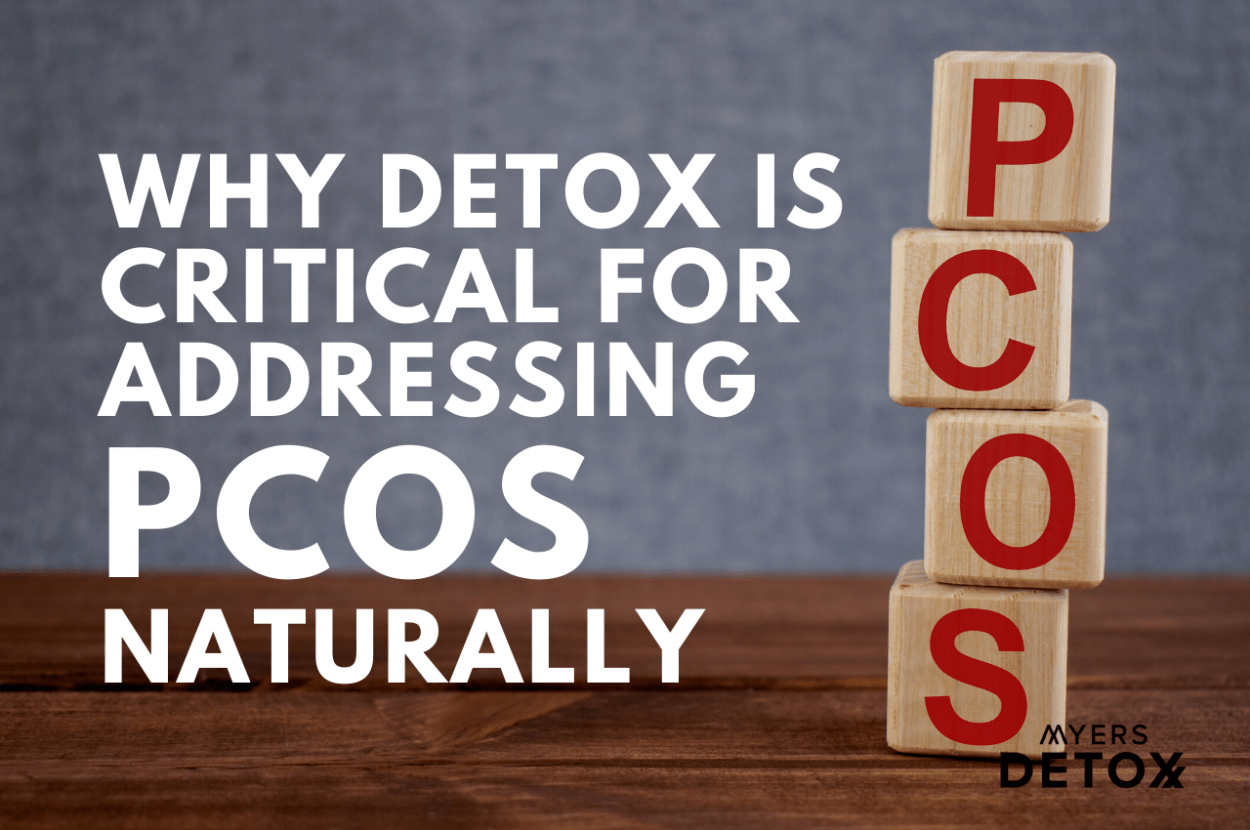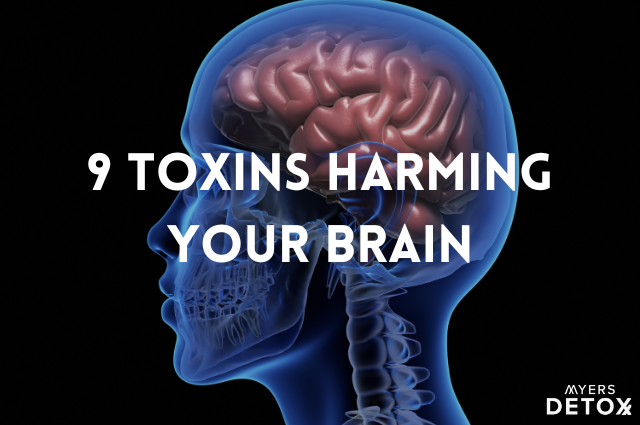Polycystic ovarian syndrome, or PCOS, affects 7–10 percent of women. It is the most common cause of infertility and the most common hormonal disorder among women, although many do not know they have it.
This is an absolutely shocking statistic. I felt it imperative to discuss how toxins greatly contribute to this disorder and how removing toxins from your home environment and from your body can go a long way to ameliorating symptoms or progression of PCOS.
While diet and lifestyle factors certainly play a role in PCOS, most practitioners overlook the well documented links to heavy metals and environmental toxins, particularly those identified as endocrine disruptors that mimic estrogen and skew hormone function.
What you’ll learn in this article:
- Many studies link estrogenic heavy metals like mercury, cadmium and nickel and toxic chemicals like BPAs and pesticides to PCOS. These compounds are endocrine disruptors that dysregulate hormone function.
- The link between fast food wrappers, nonstick pans and PCOS.
- Heavy metals and toxins can raise the risk of PCOS beginning in the womb.
- Studies have found links between PCOS and elevated copper, nickel, manganese, mercury, and cadmium.
- Zinc and chromium appear to have protective benefits with PCOS.
- Many studies show links between elevated levels of BPAs, DDT, pesticides, and industrial chemicals with raising PCOS risk.
- Air pollution, secondhand cigarette smoke, and a sunscreen ingredient have also been linked to PCOS.
- PCOS is the most common hormone disorder among women and is linked to high blood sugar and chronic inflammation.
- Symptoms of PCOS include hair growth on the face and male-pattern body hair, balding, acne, and weight gain.
- Although managing PCOS should include nutrition, stabilizing high blood sugar and addressing inflammation, it’s important not to overlook removal of toxins given their established role in PCOS in the research.
Characteristics of PCOS include:
- Ovarian cysts
- Irregular menstrual cycles
- Infertility caused by abnormal egg development and ovulation
- Elevated testosterone
The high testosterone levels resulting from this condition accounts for the more common symptoms:
- Facial and male-pattern growth of body hair
- Balding
- Acne on the face, chest, and upper back
- Weight gain
Doctors screen for PCOS with hormone tests and an ultrasound of the ovaries. If you experience any of these symptoms it may be worth getting screened.
Although genetics play a role in PCOS, it is largely associated with an inflammatory diet and lifestyle that promotes chronically high blood sugar. Many women with PCOS have insulin resistance (pre-diabetes) and type 2 diabetes, two conditions stemming from high blood sugar. Chronically high blood sugar promotes high testosterone in women and hormonal imbalances, which explains why it is linked with PCOS.
However, a common but largely overlooked contributor to PCOS is the effect of toxic heavy metals and environmental pollutants. Many of these compounds are endocrine disruptors, meaning they disrupt the female reproductive system, sometimes starting in utero.
Many chemicals and heavy metals mimic estrogen and compete with estrogen at cellular receptor sites. These chemicals bind to our estrogen receptors rather than estrogen itself. This causes a myriad numbers of problems in the body.
Heavy metals and toxins also contribute to the symptoms and complications that occur with PCOS. They deplete the body of antioxidants and promote inflammation, a double whammy contributing to the vicious cycle of high blood sugar and testosterone and imbalanced hormones seen in PCOS. Additionally, heavy metals and toxins are frequently associated in the literature with diabetes, insulin resistance and blood sugar dysregulation.
Generally, women with PCOS appear to suffer from higher levels of inflammation and oxidative stress compared to women who don’t have the disorder (8). As heavy metals and toxins deplete the body’s antioxidant reserves, this is one area women with PCOS should be mindful of addressing. They also need to be aware of proper mineralization.
The Role of Minerals like Copper, Zinc, and Manganese in PCOS
Copper levels were found to be significantly higher in subjects with PCOS in one study, and zinc, which has antioxidant effects, was found to be significantly lower than in controls (1). This study also found nickel was higher in women with PCOS, which can be estrogenic.
Women with PCOS also show a significantly higher concentration of copper in their follicular fluid compared to women who didn’t have PCOS, which could increase the secretion of estrogen (2). When you have high copper, you find high levels of estrogen. The high levels of copper in women with PCOS are also related to cardiovascular risk factors that may play a role in the increased risk of early vascular disease in women with PCOS (3).
A 2019 study also found circulating zinc levels significantly lower in women with PCOS (4). Zinc is needed for proper blood sugar control. Another study also found copper significantly higher in subjects with PCOS, but lower calcium (5). Another study found supplementing with zinc and magnesium lowered inflammation in women with PCOS (6), while another showed that zinc, magnesium, calcium, and vitamin D also lowered inflammation and reduced facial and male-pattern body hair (7).
A 2019 study found women with PCOS had significantly higher levels of nickel and manganese, and that high serum manganese levels were correlated with high prolactin levels. Researchers believe high manganese causes high prolactin (9). However, an earlier study showed that manganese was only higher in PCOS subjects who also had insulin resistance (10).
High prolactin causes infertility, irregular periods, change in menstrual flow, pauses in menstrual cycle, loss of libido, pain in breasts and vaginal dryness. Hm, all the symptoms of PCOS.
Mercury
In a 2019 rat study, researchers administered mercury to rats in amounts that mimicked what is normally found in human blood. The rats showed irregular menstrual cycles, ovarian cysts, altered follicular development, and uterine atrophy. The rats also developed elevated inflammation, high blood sugar, and insulin resistance (17).
In a June 2020 study, women with PCOS had significantly higher levels of mercury than the control group, along with antimony, lead, and cadmium (48). Mercury could play a role in PCOS because it has been shown to cause imbalances in progesterone and estrogen and to impair ovulation through its impact on feedback loops between the ovaries and the brain (49).
Cadmium
Cadmium is a very toxic heavy metal that plays a root cause role in PCOS. It gets into our bodies from fish and shellfish consumption as well as fertilizers and breathing air pollution. Most notably you acquire cadmium from smoking or second hand smoke and marijana smoking. ALL smokers are cadmium toxic without exception.
A 2016 study isolated follicular cells from women with both PCOS and insulin resistance and incubated them with cadmium. They found that compared to controls, the cadmium increased cell death, decreased hormone production, and led to abnormal development of the follicle. The researchers suggested these actions compromise fertility (18).
Environmental Toxins and PCOS
Many of the environmental chemicals we interact with every day are endocrine disruptors, meaning they interfere with normal hormonal function and can contribute to the development of PCOS (19–22). This is often due to the fact that they mimic estrogen and thus interfere with estrogen’s roles in the body.
The impacts of these chemicals on hormone function can begin while still in the womb and in infancy and even be passed down from there (23–25). In animal studies, exposure to BPA around the time of birth at levels that mimic usual human exposure dramatically disrupted reproductive function and led to weight gain (26).
BPAs
Perhaps the most commonly known endocrine-disrupting chemical is bisphenol-A (BPA) (27), the compound found in plastics, in the coating on store receipts, in the liner of food containers, in health and dental equipment, and in many other products.
BPA mimics estrogen at cellular receptor sites and has been shown to play a role in early-onset puberty, infertility, hormonal tumors, and PCOS. BPA accumulates in the body over time, causing a toxic body burden over time (28).
Women with PCOS show significantly higher levels of BPA compared to controls (29–32), and it is linked to the excess production of testosterone (33, 34), the downregulation of estrogen synthesis (35), and a reduction in the ability to produce viable eggs (36) in women with PCOS compared to controls (37).
BPA may also play a role in high triglycerides and cholesterol in these women (38). Higher levels of BPA in women with PCOS was also correlated with larger spleen volume, an indicator of chronic inflammation (39).
Pesticides and Organic Pollutants
Persistent organic pollutants like PCBs, pesticides, DDT and PAHs are industrial chemicals in our environment that have been shown to affect fertility and cause serious reproductive problems, including lack of ovulation, premature ovarian failure, and PCOS.
These pollutants are transported by wind and water from different countries around the world. They persist for long periods of time in the environment, accumulate in body tissue, and can pass from one species to the next through the food chain. Numerous studies show they are endocrine disruptors that impact female reproductive health and are linked to disorders such as PCOS.
For instance, a study of women in China found a significant association between PCOS and elevated levels of pollutants, including polychlorinated biphenyls (PCBs), organochlorine pesticides, and polycyclic aromatic hydrocarbons (PAHs) (40). PCBs and organochlorine pesticides have been banned in the US but are still used in developing countries. PAHs are produced from the burning of coal, oil, gas, and wood, which is transported by weather patterns across the globe.
Serum levels of perfluorinated alkyl acids, an industrial chemical, were found to be higher in women with PCOS and were associated with higher testosterone levels (41) and increased risk of PCOS-related infertility (42).
Although the pesticide DDT has not been used for decades in the US due to its toxicity, it still persists in our environment and continues to be used on food crops in other parts of the world and can make its way around the globe on wind and water. A 2017 study found that women with PCOS showed significantly higher serum levels of DDT than controls, suggesting DDT may play a role in the development of PCOS (43).
In a 2014 Los Angeles study, women with PCOS were found to have higher levels of a number of toxic environmental compounds compared to controls, including perfluorinated compounds like including PFOAs used in nonstick pans, grease-proofing agents are coatings on paper wrappers such as fast-food wrappers, microwave popcorn bags, and pet food bags, stain repellents for textiles, additives to paper products, and in aqueous film forming foams used to fight fires. Researchers suggested these chemicals may play a role in the development of PCOS (44).
In addition to toxicity from industrial chemicals and pesticides, research has also found links between PCOS and cigarette smoke, air pollution, and a common sunscreen chemical.
A Chinese study of 500 women with PCOS found those exposed regularly to second-hand smoke showed higher levels of testosterone, insulin resistance, lowered sex hormone binding globulin (proteins that transport hormones through the bloodstream), and reduced conception rates (45). We know cigarette smoke creates significant exposure to cadmium, however this study did not specifically analyze cadmium levels.
In a study of more than 90,000 women in Taiwan, about 2,000 had developed PCOS by the time of a 12-year follow-up. The women that developed PCOS had been exposed to high levels of air pollution and were found to have higher levels of these pollutants in their blood than the women who did not develop PCOS (46).
A common ingredient in sunscreens, octocrylene, was significantly associated with an increased risk of PCOS in overweight and obese women (47).
Improving Blood Sugar Control in PCOS
Chromium, zinc and calcium are KEY in synthesizing and controlling insulin and cellular sensitivity in PCOS (and blood sugar issues in general).
These minerals are proven in studies to be lower in patients with diabetes and PCOS: (50)
Chromium gets insulin to cells’ receptors. The role of chromium, a trace metal much studied for its role in lowering high blood sugar, has also been explored in relation to PCOS. Women with PCOS and high blood sugar and insulin also appear to have low levels of chromium (11, 12).
Supplementing with chromium has been shown to help subjects with PCOS stabilize blood sugar, improve antioxidant status (13), regulate menstrual cycles, lower testosterone (14), improve acne and hirsutism, lower inflammation (15), and improve insulin resistance (16).
Zinc releases insulin. Low zinc will decrease release of insulin from the pancreas. Zinc is required for insulin production, release and to extend the duration of the action of insulin. (51) It’s critical to supplement zinc to improve blood sugar control.
Many people today have an odd state of affairs happening in their body when it comes to calcium. They have too much built up in their tissues that is biounavailable, which leaves them in a state of calcium deficiency.
Proper calcium balance is required to suppress insulin. Calcium deficiency can cause the pancreas to put out too much insulin causing hypoglycemia. High levels of biounavailable calcium in the tissues will reduce the release of insulin from the pancreas.
Calcium acts as a blockade. If calcium builds up inside cells it almost creates a plaque that prevents insulin, nutrients and hormones (including thyroid hormones) from getting into cells. This occurs with exposure to EMF (electromagnetic fields like wireless internet). Which is why we see the correlation to blood sugar issues and weight gain with long term and increasing exposure to EMFs.
When minerals are out of balance it can cause diabetes and blood sugar imbalances. You simply have to replenish and balance all nutrients and minerals to better control blood sugar.
What you can do to detox your reproductive organs from heavy metals and toxins
To protect your reproductive and hormonal health from heavy metals and pesticides, follow this four-step process:
- Mobilize heavy metals and toxins from body tissues.
- Bind them so they don’t lodge elsewhere in the body.
- Support the body’s pathways of elimination so they immediately leave the body.
- Mineralize the body so heavy metals and toxins don’t take the place of valuable minerals due to deficiency.
I formulated CitriCleanse to cover all of these steps. This is an all-in-one formula that only requires one scoop daily in water to support the body’s natural excretion of harmful pollutants. Made from pure ingredients, it is amazingly effective at aiding your body’s innate ability to mobilize toxins and heavy metals, help flush them from the body, and mineralize your tissues.
My clients who use CitriCleanse report more energy, better sleep, improved digestion, heightened mental clarity, and improved hormone function.
CitriCleanse is highly unique for three key reasons:
Fulvic humic acid: Fulvic humic acid provides your tissues with minerals, which then supports the removal of environmental contaminants, so they’re not competing with thyroid hormones.
Cilantro extract: Cilantro extract supports the body’s natural detoxification pathways in its removal of mercury, cadmium, lead, and aluminum from your cells, tissues, bones, and nervous system.
Grapefruit pectin: Grapefruit citrus pectin has been processed in a way that makes its molecules small enough to cross the intestinal barrier and to get into the bloodstream. This allows the grapefruit citrus pectin to gently surround and support the excretion of pollutants that are both freely circulating in your bloodstream as well the ones that have become lodged in tissues and organs. I only use the purest modified citrus pectin (MCP) available—other products often use brown algae as fillers to lower cost (and effectiveness).
If you’d like to learn more about supporting your body’s natural detoxification process, click here.
Takeaway
PCOS is not just the result of genetics or lifestyle and diet choices. Heavy metals contribute to all the symptoms of PCOS directly and indirectly. Blood sugar issues, diabetes, hormone imbalances, infertility and weight gain are all caused by toxins and heavy metals. And an overwhelming amount of research links PCOS with heavy metals directly.
Mineral deficiencies also play a large role in the many symptoms that result from PCOS. It’s prudent to test for and balance minerals to improve PCOS-related symptoms, but also to improve overall bodily function. Mineral deficiency also plays a role in the body accumulating heavy metals and conversely, repleting minerals aids in displacing and detoxing metals from the body.
Toxic heavy metals and environmental compounds are ubiquitous in our environment. Whether one has PCOS diagnosis or not, it’s prudent to employ safe and natural tools on a daily basis to keep ourselves detoxed and healthy.










